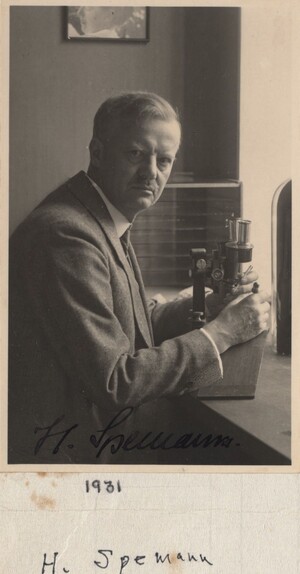Hans Spemann, who directed the Zoological Institute at Freiburg that had been established by August Weismann (1834-1914), accepted Hamburger as a graduate student for the year 1920-21. Spemann had attracted a number of outstanding young biologists to his laboratory, which they recalled as a friendly and open place to work. During this time, Spemann continued his experiments with transplantation of tissues in amphibians (frogs and salamanders). He was asking fundamental questions about what directs development and differentiation of parts. His techniques of transplanting embryonic regions from younger to older embryos (or vice-versa) led to the concept of embryonic induction, the process by which previously-differentiated tissues trigger the next stage of differentiation, in a kind of cascade, in the developmental sequence. But what started the process in the first place? In a particularly revealing experiment published in 1924, Spemann and his student Hilde Proescholdt Mangold (1898-1924), using salamanders, transplanted a portion of the dorsal lip of the blastopore (the region of the gastrula just above the point of invagination) into the blastocoel, or entral cavity of the blastula of a host embryo. The result was spectacular: an entire, second embryo with its own set of differentiated parts was induced in the host blastocoel [See drawing from Hamburger and Holtfreter in Willier, Weiss and Hamburger, or NAS Biog., p. 8]. The ability of the dorsal lip of the blastopore to have this profound effect earned it the title of the “organizer”, or “primary inducer”. As Spemann and others would soon recognize, however, induction was a much broader phenomenon. Different pieces of tissue seemed to induce different results, and while the Spemann lab catalogued and correlated those effects, it soon became clear that induction was not a simple linear process. Nonetheless, this transplantation approach soon led to a major research program for many embryologists.
- Allen, Garland E. "A Pact with the Embryo: Viktor Hamburger, Holistic and Mechanistic Philosophy in the Development of Neuroembryology, 1927–1955." Journal of the History of Biology 37 (2004): 421–75.
- Cowan, W. Maxwell "Viktor Hamburger and Rita Levi-Montalcini: The Path to the Discovery of Nerve Growth Factor." Annual Review of Neuroscience 24 (2001): 551–600.
- Hamburger, Viktor. "The Journey of a Neuroembryologist." Annual Review of Neuroscience 12 (1989): 1–12.
- MBL History Project. (2016). Victor Hamburger Papers. https://hpsrepository.asu.edu/handle/10776/9/discover
- Maienschein, Jane. (2011). Maienschein: 100 Years Exploring Life. Charleston: Nabu Press.

